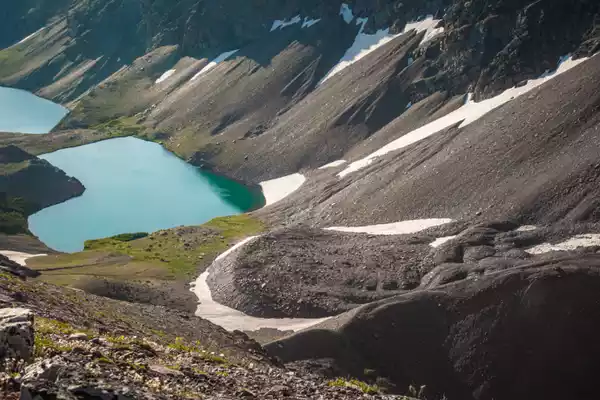More than 100 active permafrost structures identified in the Jhelum basin pose a potential threat of catastrophic disasters in the future.
Rock glaciers in Kashmir Himalayas:
- The Kashmir Himalayas feature numerous permafrost structures known as ‘rock glaciers’, characterized by substantial ice volumes within them.
- Over 100 of these structures exhibit ridges and bulges, suggesting the onset of movement or melting in the permafrost within them.
- Referred to as ‘active glacial rocks,’ these structures may pose a heightened risk of contributing to natural disasters as the region experiences warming.
- Active rock glaciers near glacial lakes, like Chirsar Lake, increase the risk of glacial lake outburst floods (GLOFs) and landslides, with potential melting leading to slope failures, exposing permafrost, and contributing to downstream water sources.
- Despite risks, rock glaciers hold large volumes of frozen water, acting as valuable reserves in regions facing water source depletion.
- The Jhelum basin alone stores a trillion liters of frozen water in active rock glaciers.
About the Rock glaciers:
- Rock glaciers are a type of landform that combines features of both glaciers and rock.
- Rock glaciers, distinctively formed in mountainous regions with a combination of permafrost, rock debris, and ice, often appear as regular ground, leading to habitation planning challenges that require a geomorphological perspective for accurate identification.
- These formations typically occur in mountainous regions and are often found at high elevations.
- Similar to traditional glaciers, rock glaciers can exhibit slow movement over time.
- This movement is typically driven by the downslope flow of the underlying ice under the influence of gravity.
- The rate of movement is much slower than that of typical glaciers, often measured in centimeters per year.
- Unlike an ice glacier, rock glaciers usually have very little ice visible at the surface.
Formation:
- Rock glaciers often form in mountainous regions where there is an abundant supply of loose rock debris and permafrost.
- The rock debris accumulates on top of the permafrost, and as ice forms within the debris, a rock glacier is born.
- Rock glaciers can appear as a mass of angular rocks with ice visible between them.
- The surface may be irregular and often shows evidence of movement, such as crevasses and ridges.
What is permafrost?
- Permafrost is a type of ground that remains consistently frozen for a significant portion of the year, typically for at least two consecutive years.
- It is characterized by soil, rock, or sediment that stays at or below freezing point (0 degrees Celsius or 32 degrees Fahrenheit) for extended periods, often for decades or even centuries.
- It is found in regions with extremely cold climates, such as the Arctic, subarctic, and some high-altitude mountainous areas.
- The frozen condition of permafrost is not solely due to air temperature but is also influenced by factors like the presence of snow cover, vegetation, and the insulating properties of the ground itself.
- It contains varying amounts of ice, which may exist in the form of ice lenses, segregated ice, or massive ice wedges, depending on the specific conditions.
Importance of Permafrost:
- It plays a crucial role in shaping the landscape and ecosystems of the regions where it occurs.
- It can have significant implications for infrastructure, as buildings and roads may be affected by the thawing and shifting of permafrost.
- Additionally, permafrost contains large amounts of organic carbon that has been preserved in a frozen state.
- When permafrost thaws, it can lead to the release of greenhouse gases, such as carbon dioxide and methane, into the atmosphere, contributing to climate change.
- The potential release of these gases from thawing permafrost is a significant concern for global climate scientists.
Global distribution:
- Around 15% of the Northern Hemisphere or 11% of the global surface is underlain by permafrost.
- This includes substantial areas of Alaska, Greenland, Canada, and Siberia.
- It is also located in high mountain regions, with the Tibetan Plateau a prominent example.
- Only a minority of permafrost exists in the Southern Hemisphere, where it is consigned to mountain slopes like in the Andes of Patagonia, the Southern Alps of New Zealand, or the highest mountains of Antarctica
Ref: Source
| UPSC IAS Preparation Resources | |
| Current Affairs Analysis | Topperspedia |
| GS Shots | Simply Explained |
| Daily Flash Cards | Daily Quiz |



